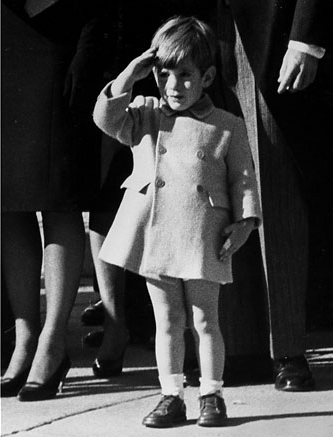The Public Editor at the Sunday New York Times had a lengthy column yesterday, and for good reason: he had a lot of explaining to do. The Times, along with many others, was taken in by photographer Joe O’Donnell’s fraudulent claim that he had taken the iconic photo of John-John Kennedy saluting his father’s caisson:
The problem was that the Times obituary for Mr. O’Donnell had featured the iconic image as his signature photo. As the paper soon learned–and reported–the photo had been taken by Stan Stearns, not O’Donnell. In fact, a second photo shown also had been taken by someone else, and soon a string of deceptions came to light.
Those who love to hate the Times will enjoy their evident mortification, but I’m not among that crowd. They were working at the demanding pace at which they nonetheless produce detailed and reliable stories day after day after day. More important, they were taken in by someone who apparently spent years crafting elaborate deceptions. It’s easy to be fooled by someone who already has fooled many of the people you trust.
The several stories provide an interesting glimpse into both the work of a con artist and the way stories are put together at the Times. They also reveal a thing or two about visual culture today. For one, the fascination with iconic images continues. In an earlier post I asked “Is there an icon for everything?” Well, it seems there has to be for noteworthy photographers. As quoted by the Public Editor, the night photo editor at the Times set aside his reservations about O’Donnell’s claim about the photo because “That the Times was writing the obituary made it ‘a done deal as far as I was concerned,’ he said. ‘I assumed that Joe O’Donnell, famous photographer, had already been verified, and my job was to find iconic images to illustrate his career.'” There you have it: famous photographers, like the great events they cover, must each have their iconic shots. Unfortunately, O’Donnell had taken other images that also deserved to be seen. Instead of yet another Kodak Moment with dead Kennedys, the Times missed an opportunity to show its readers something of the Cold War. Icons are important, but they should not be used to paper over the rest of the visual archive.
A second point allows me to grind another ax. One way or another many people in academia, the press, and more generally have picked up Susan Sontag’s critique of photography. Fortunately, nodding along to Sontag doesn’t inhibit their actual viewing practices–let’s hear it for hypocrisy–but they nonetheless parrot her arguments when talking about photography. Thus, we are re-exposed to her anxiety about the power of the visual image to counterfeit reality, to be manipulated, to deceive, and generally to corrupt our ability to know the world and be ethical. Images can do all of that, of course, but no medium or art is innocent of these charges. And that’s what I love about this episode with John-John. O’Donnell deceived a lot of people about the photograph–but not with the photograph. No, to fabricate reality he used another technology, one that also has a very good track record for deception: words.
Photograph by Stan Stearns/Corbis.

I’m very ambivalent about Sontag. It’s on my list to write a review of her book, although it’s sitting pretty low down the to-be-read pile, so it may never happen. There are some conceptual snippets I like though, more recently the “surrealist abbreviation of history”, and how that resonates on a personal level with the ‘me’ that’s in the content for example, of my father’s prolific photographic oevre. How that translates outwards I’m far less sure.
We all should be ambivalent about Sontag on photography. She merited her early influence, but it really is time to move on. For a review of At the Same Time that I think makes a good effort at coming to a balanced assessment of her oeuvre, see Eliot Weinberger, “Notes on Susan,” New York Review of Books, August 16, 2007.
Thank you, I will. It’s probable I’ll be in your audience on Saturday. Looking forward to it. 🙂
[…] “For every minute you are angry you lose sixty seconds of happiness.”Julian Germain Notes on Susan by Eliot Weinberger. Sontag’s On Photography (1977) “her contentious love-hate letter to the “quintessential art of affluent, wasteful, restless societies,” remains the best introduction to the subject, not only a fairly comprehensive brief history but Sontag’s finest display of her synthetic skills, managing to incorporate nearly everything that has been thought or said on photography into a free-flowing argument that would become one of her perennial themes: how photographs… those “clouds of fantasy and pellets of information” have become a “pseudo-presence” more real than the real itself in a world dependent on their production and consumption.” via NCN […]